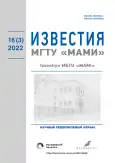Results of application of porous permeable SHS catalytic blocks in multistage converters, diesel exhaust gases
- Authors: Melbert A.A.1, Nguyen T.H.1, Mashensky A.V.1, Sokolova V.A.2
-
Affiliations:
- Polzunov Altai State Technical University
- Military Telecommunication Academy named after the Soviet Union Marshal Budienny S. M.
- Issue: Vol 16, No 3 (2022)
- Pages: 201-208
- Section: Heat engines
- URL: https://journals.rcsi.science/2074-0530/article/view/126626
- DOI: https://doi.org/10.17816/2074-0530-106160
- ID: 126626
Cite item
Full Text
Abstract
BACKGROUND: According to the statements of leading experts in the diesel industry, in order to introduce standards for the levels of harmful emissions into the atmosphere, it is necessary to use particulate filters and catalytic converters, which will increase the efficiency of exhaust gas conversion and improve the environmental performance of diesel engines.
AIMS: Educing harmful emissions into the atmosphere, improving the quality and reducing the cost of cleaning exhaust gases during the implementation of the life cycles of transport energy facilities by using porous SHS blocks in catalytic converters and particulate filters.
METHODS: Stand tests of prototypes of neutralizers of the AltSTU design with one, two and three stages of purification were carried out. The first stage is a particulate filter made of porous permeable SHS material, the second stage is an oxidizing SHS block, the third stage is a catalytic reducing SHS block. To obtain catalytic blocks by the SHS method, the following charge composition was used: iron scale 18X2H4MA -47.5%; chromium oxide PH-1 according to TU 882-76 – 17.7%; nickel powder PNK-OT-1 according to GOST 9722-79 – 4.9%; aluminum powder according to TU 485-22-87 grade ASD-1 – 15%, copper – 11%; aluminum oxide – 3.8%; iridium – 0.01%. The charge of the recovery unit consisted of 14.5% copper. The resulting blocks had a permeable structure and high strength. The average pore size was 180 microns. Neutralizers were installed butt-to-butt with a turbocharger.
RESULTS: It was revealed that NOx emissions according to the load characteristic of the KamAZ-740 diesel engine at 2600 min-1 decrease at average effective pressures Pe equal to 0.03; 0.55; 0.77 MPa from 3.82...11.62...9.49 g/m3, respectively, to 3.23...6.52...4.61 g/m3 or approximately 13...44...53%. Reduction of emissions of solid particles at the same loads was 75; 45; 63%, of hydrocarbons – 72; 53; 54%. The minimum specific fuel consumption was observed in the range of 1600...2000 min-1 according to the external speed characteristic. When using a neutralizer with two catalytic units installed in series, emissions from hydrocarbon exhaust decreased from 3.12...1.21 to 0.90...0.29 g/m3, or by 71...76%. The degree of CO conversion was 78...73%; NOx – 4...52%, and the total purification coefficient was a coaxial installation of additional blocks made of SHS-catalytic materials has led to an improvement in the quality of cleaning up to 0,698. Over 360 hours of operation, the efficiency of PM conversion decreased from 55 to 45%, CO – from 58 to 46%, NOx – from 65 to 44%, which indicated the beginning of deactivation of catalysts.
CONCLUSIONS: The use of multi-stage neutralizers with SHS-catalytic units can reduce emissions of hydrocarbons by 1.95 times, carbon monoxide by 3.6 times, nitrogen oxides by 2 times, solid particles by 3 times, ensuring compliance with Russian standards.
Full Text
##article.viewOnOriginalSite##About the authors
Alla A. Melbert
Polzunov Altai State Technical University
Email: aamelbert@mail.ru
ORCID iD: 0000-0002-3973-8315
SPIN-code: 5949-5831
Dr. Sci. (Tech.), Professor, Head of the Life Safety Department
Russian Federation, 46 Lenina avenue, 656000, BarnaulTran Hung Nguyen
Polzunov Altai State Technical University
Email: hungtnut.nguyen@gmail.com
ORCID iD: 0000-0002-0276-2303
SPIN-code: 5702-0442
Post Graduate
Russian Federation, 46 Lenina avenue, 656000, BarnaulAlexander V. Mashensky
Polzunov Altai State Technical University
Email: aleksandr.mashenskiy@mail.ru
ORCID iD: 0000-0003-4013-8648
SPIN-code: 6339-5630
Scopus Author ID: 1160841
Engineer, Graduate of the Life Safety Department
Russian Federation, 46 Lenina avenue, 656000, BarnaulViktoria A. Sokolova
Military Telecommunication Academy named after the Soviet Union Marshal Budienny S. M.
Author for correspondence.
Email: sokolova_vika@inbox.ru
ORCID iD: 0000-0001-6880-445X
SPIN-code: 5116-5102
References
- Novoselov AL, Melbert AA, Zhuikova AA. Application of SHS-materials in solving environmental problems of transport. Novosibirsk: Nauka; 2007. (in Russ).
- Novoselov AL, Prolubnikov VI, Tubalov NP. Improving the purification of exhaust gases of diesel engines based on SHS materials / ed. VV Evstigneeva. Novosibirsk: Nauka; 2001. (in Russ).
- Melbert AA, Novoselov AA. Catalytic purification of diesel exhaust gases. / ed. A.A. Melbert. Barnaul: Izd-vo AltGTU; 2017. (in Russ).
- Kirasirov OM, Nesterenko GA, Starichkov VI. Neutralization of exhaust gases of internal combustion engines of automobiles. National Association of Scientists. 2015;5–2(10):87–91. (in Russ).
- Kornilov GS. Creation of diesel exhaust gas cleaning systems. Privodnaya tekhnika. 2005;3:16–21. (in Russ).
- Yang S, Deng C, Gao Y, et al. Diesel particulate filter design simulation. A review. Advances in Mechanical Engineering. 2016;8(3):1–14. doi: 10.1177/1687814016637328
- Venkatesh L, Logeshkumar R, Jayaprakash G, et. al. Control and reduction of emissions using catalytic converter. International Research Journal of Engineering and Technology (IRJET). 2017;04(11);788–794.
- years in the development of autocatalysis. Platinum. 2004;6:32–37.
Supplementary files










